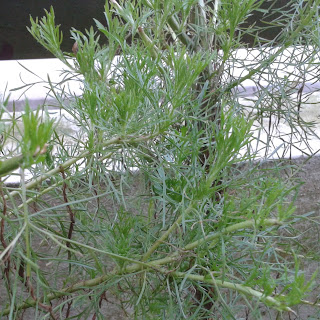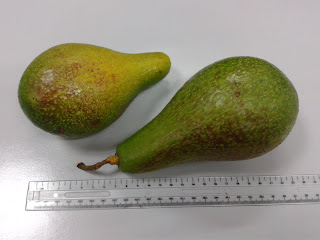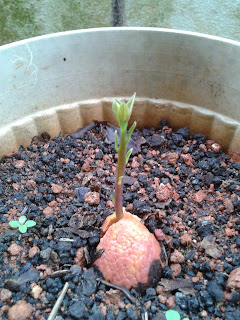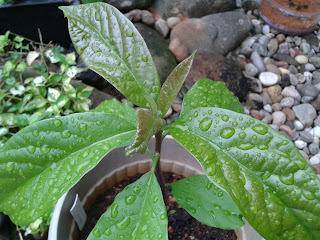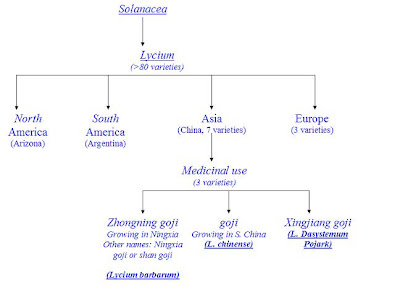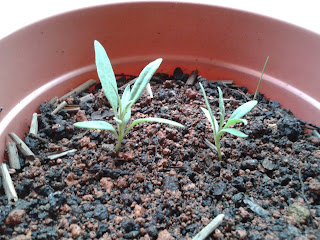Miracle Berry
Just suck a red ripe miracle berry in your mouth for about 30 seconds to a minute. All things bitter or sour that you consume in the next half hour will taste sweet.
Slow grower. Partial shade or full sun. Not picky about medium but best grown in organic rich soil.
The tiny milk colour flowers are sweet scented and can be whiffed from a few metres away.
A winged red fire ant queen looking to start a new colony. The red fire ants seem attracted to this tree. Must be the sweet flowers. This is not the first time a red fire ant queen picked my miracle berry plant to start a new colony.
Just another small fry scalping for pittance in a sea of sharks. ikan bilis main kupiao was originally to log kupiao matters of interest, but now houses what-not of interest.
Sunday 25 September 2011
Friday 23 September 2011
Flora : Southernwood
Southernwood / Lad's Love
http://en.wikipedia.org/wiki/Southernwood
Southernwood easily strikes root from young or old wood cutting.
It grows well in full shade, partial shade or full sun.
Not picky about the planting medium.
It just needs occasional feeding and good soil moisture.
Southernwood is a rigorous grower, sprouting new shoots from ground and trimmed stems.
It will grow into a big bush if planted in ground and left untrimmed.
Make a very aromatic garnish for steaming fish. Just cut a few stalks and place them on the steamer pan, and stuff a few sprigs into the fish's belly.
Try experimenting with stews. Just bear in mind southernwood is a strong aromatic herb.
http://en.wikipedia.org/wiki/Southernwood
Southernwood easily strikes root from young or old wood cutting.
It grows well in full shade, partial shade or full sun.
Not picky about the planting medium.
It just needs occasional feeding and good soil moisture.
Southernwood is a rigorous grower, sprouting new shoots from ground and trimmed stems.
It will grow into a big bush if planted in ground and left untrimmed.
Make a very aromatic garnish for steaming fish. Just cut a few stalks and place them on the steamer pan, and stuff a few sprigs into the fish's belly.
Try experimenting with stews. Just bear in mind southernwood is a strong aromatic herb.
Wednesday 21 September 2011
Flora : Pandan Leaves
Pandan leaves
The fragrant leaves with many uses...
As natural air fresherner.
As mulch/ ground cover.
As indoor/outdoor decorative plant.
To make infused tea.
To make jello.
To make cake.
To cook fragrant rice.
To cook desserts.
To cook pandan chicken.
Etc.
Not only is it fragrant, it is also mildly sweet.
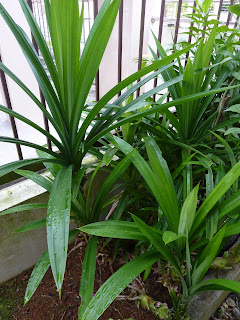
The fragrant leaves with many uses...
As natural air fresherner.
As mulch/ ground cover.
As indoor/outdoor decorative plant.
To make infused tea.
To make jello.
To make cake.
To cook fragrant rice.
To cook desserts.
To cook pandan chicken.
Etc.
Not only is it fragrant, it is also mildly sweet.

Tuesday 20 September 2011
Flora : Avocado
Avocado
30 Jul 2011
This is a purple skin (when fully ripen) avocado originated from New Zealand. The parent plant is successfully cultivated in the tropical climate with good fruiting seasons starting from the fifth year.
The fruit measures about 14cm in length.
This is intentionally over-ripen avocado fruit cut in half to harvest the pit for improved germination probability. Very decent amount of flesh compared to certain green skinned species.
Cleaned avocado pits ready for planting.
.
29 Aug 2011
.04 Sep 2011
Monday 5 September 2011
Flora : Goji
Goji /Wolfberry/ Lycium
(More specifically, Chinese wolfberry)
Reference: http://go-goji.com/default.aspx
Project Zhongning Goji
Left: Zhongning goji (L. barbarum); Right: chinese goji (L. chinense)
Zhongning goji is bigger in size. The pulp is also softer and sweeter. The dried chinese goji is harder and slightly bitter tasting.
I am now experimenting with Zhongning goji planting.
29 July 2011
One week old seedlings... 1cm tall.
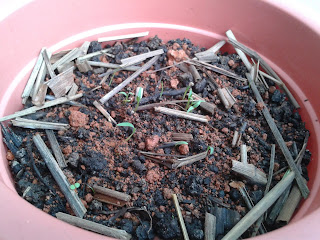
(More specifically, Chinese wolfberry)
Reference: http://go-goji.com/default.aspx
Project Zhongning Goji
Left: Zhongning goji (L. barbarum); Right: chinese goji (L. chinense)
Zhongning goji is bigger in size. The pulp is also softer and sweeter. The dried chinese goji is harder and slightly bitter tasting.
I am now experimenting with Zhongning goji planting.
29 July 2011
One week old seedlings... 1cm tall.

05 August 2011
First true leaves...
16 August 2011
Transplanted into individual pots. Two seedlings per pot.
There are a couple of pointers that I have picked up thus far in my Goji planting experiment.
Germination rate. The germination rate is actually not bad. From each goji fruit, I can get in average 6~8 successful germination. This is what I feel is the best germination method.
- Soak the fruit overnight. Soaking the fruit overnight seems to give higher, more uniformed germination rate.
- Remove the seeds from the flesh and just buried them slightly in the germination bed. Water them in lightly.
- Goji is sun loving. Keep the seeds in partial shade (preferably morning sun). Moisten the soil every morning. Keep out from rain to avoid seeds from getting displaced.
- Once germinated with the first pair of leaves formed, cut back on watering. Water every other day, depending on the weather. Keep it under partial shade. Goji dislike damp soil.
By the second week, first true leaves will form. And by third week, you should get three sets of true leaves. The seedlings are ready for transplant. After transplant, keep in full shades for few days for the root shock to wear off. Then place the seedling back under partial shade.
At this stage, there are some signs of red spider mite infestation. I am keeping a close monitor on the seedlings and will administer pesticide if the infestation becomes serious.
Spider mite infestation normally becomes a problem for plants placed in a shielded place away from rain. A good regular spray of water will usually keep the spider mites under check. But the seedlings are still fragile in this case. By the time they are sufficiently strong, the seedlings will be out there under the full sun :)
p/s: By second or third week, if the goji seedlings have not gotten past the first true leaves, the soil is either too damp or there is insufficient sun. A quick fix is needed.
p.p/s: Going to give the transplanted seedlings their first organic booster feeding once they are established.
04 September 2011
The seedlings took one to three weeks to recover from transplant shock depending on the severity of root damage.
Newly transplanted seedlings from second batch that were sown two weeks after the first batch. The seedlings are the similar sized to seedlings from first batch.
During the second transplant operation I realised the Goji plant has a very deep rooting system. The "trunk" root will dig all the way down to the bottom of the pot and spread out into a maze of fine hair roots. It was extremely difficult to separate the tangled roots of multiple plants. In many cases, the fine hair roots were snapped. I think the second batch will take a while to recover from the transplant shock.
One valuable lesson is to start germination from individual pot/planter. The germination rate is quite high, so my guess it is sufficient to sow 3~4 seeds per pot and thin out to one strongest plant per pot later on. This way, transplant shock can be minimised as the entire root ball can be transplanted (compared to bare root transplant) and also at a later stage of the seedling growth, perhaps direct into the field if the initial germination pot is sufficiently big for growth beyond initial seedling growth.
Flora : Water Hyacinth
Water Hyacinth / Keladi Bunting / Eichhornia Crassipes
From a few aquatic plants I tested to control algae growth in an outdoor water setting, water hyacinth not only produces showy purplish flowers, it is the most effective too.
I planted the mother plant in a vase and let the daughter plants propagate out in a controlled manner. As water hyacinth is a free floating plant, this anchors the plant at placed position. Here, it acts as a water filtration system and a show piece.
Water hyacinth is nutrient hungry, soaking up whatever nutrient it can get from the water body, thus depriving the algae of food. The end result is clear water once an equilibrium is achieved. In fact, the water hyacinth is really nutrient hungry I have to feed it with bloom fertilizer once a week for it to grow happily and flowers.
Water hyacinth can propagates very fast from a single mother plant, but only in nutrient rich water like polluted waterway or pond with agriculture runoff, or to that effect. Here, it only propagates if I supplies sufficient fertilizer to it. The fertilizer is supplied directly to the roots which is pretty much contained inside the vase.
Occasional pruning is needed to removes dead leaves and spent flower stalks. But it is also fine with no pruning as the dead leaves and spent stalks will slowly decompose, providing nutrient.
Water hyacinth also acts as a good shade/shelter for aquatic life in you water body.
http://en.wikipedia.org/wiki/Water_hyacinth
From a few aquatic plants I tested to control algae growth in an outdoor water setting, water hyacinth not only produces showy purplish flowers, it is the most effective too.
I planted the mother plant in a vase and let the daughter plants propagate out in a controlled manner. As water hyacinth is a free floating plant, this anchors the plant at placed position. Here, it acts as a water filtration system and a show piece.
Water hyacinth is nutrient hungry, soaking up whatever nutrient it can get from the water body, thus depriving the algae of food. The end result is clear water once an equilibrium is achieved. In fact, the water hyacinth is really nutrient hungry I have to feed it with bloom fertilizer once a week for it to grow happily and flowers.
Water hyacinth can propagates very fast from a single mother plant, but only in nutrient rich water like polluted waterway or pond with agriculture runoff, or to that effect. Here, it only propagates if I supplies sufficient fertilizer to it. The fertilizer is supplied directly to the roots which is pretty much contained inside the vase.
Occasional pruning is needed to removes dead leaves and spent flower stalks. But it is also fine with no pruning as the dead leaves and spent stalks will slowly decompose, providing nutrient.
Water hyacinth also acts as a good shade/shelter for aquatic life in you water body.
http://en.wikipedia.org/wiki/Water_hyacinth
Subscribe to:
Posts (Atom)



